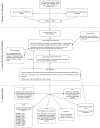ProMED-mail: 22 years of digital surveillance of emerging infectious diseases
- PMID: 28582558
- PMCID: PMC5881259
- DOI: 10.1093/inthealth/ihx014
ProMED-mail: 22 years of digital surveillance of emerging infectious diseases
Abstract
ProMED-mail (ProMED) was launched in 1994 as an email service to identify unusual health events related to emerging and re-emerging infectious diseases and toxins affecting humans, animals and plants. It is used daily by public health leaders, government officials at all levels, physicians, veterinarians and other healthcare workers, researchers, private companies, journalists and the general public. Reports are produced and commentary provided by a global team of subject matter experts in a variety of fields including virology, parasitology, epidemiology, entomology, veterinary and plant disease specialists. ProMED operates 24 hours a day, 7 days a week and has over 83 000 subscribers, representing every country in the world. Additionally, ProMED disseminates information via its website and through social media channels such as Twitter and Facebook as well as through RSS feeds. Over the last 22 years, it has been the first to report on numerous major and minor disease outbreaks including SARS, MERS, Ebola and the early spread of Zika. ProMED is transparent, apolitical, open to all and free of charge, making it an important and longstanding contributor to global health surveillance.
Keywords: Emerging infectious diseases; EpiCore; Outbreaks; ProMED-mail; Surveillance.
© The Author 2017. Published by Oxford University Press on behalf of Royal Society of Tropical Medicine and Hygiene. All rights reserved. For permissions, please e-mail: journals.permissions@oup.com.
Figures




Similar articles
-
Global surveillance of emerging diseases: the ProMED-mail perspective.Cad Saude Publica. 2001;17 Suppl:147-54. doi: 10.1590/s0102-311x2001000700024. Cad Saude Publica. 2001. PMID: 11426276
-
Early Detection of Public Health Emergencies of International Concern through Undiagnosed Disease Reports in ProMED-Mail.Emerg Infect Dis. 2020 Feb;26(2):336-339. doi: 10.3201/eid2602.191043. Emerg Infect Dis. 2020. PMID: 31961311 Free PMC article.
-
ProMED-mail: an early warning system for emerging diseases.Clin Infect Dis. 2004 Jul 15;39(2):227-32. doi: 10.1086/422003. Epub 2004 Jun 28. Clin Infect Dis. 2004. PMID: 15307032
-
The internet and the global monitoring of emerging diseases: lessons from the first 10 years of ProMED-mail.Arch Med Res. 2005 Nov-Dec;36(6):724-30. doi: 10.1016/j.arcmed.2005.06.005. Arch Med Res. 2005. PMID: 16216654 Review.
-
Web-Based Surveillance Systems for Human, Animal, and Plant Diseases.Microbiol Spectr. 2014 Feb;2(1):OH-0015-2012. doi: 10.1128/microbiolspec.OH-0015-2012. Microbiol Spectr. 2014. PMID: 26082109 Review.
Cited by
-
Drawing on the Development Experiences of Infectious Disease Surveillance Systems Around the World.China CDC Wkly. 2024 Oct 11;6(41):1065-1074. doi: 10.46234/ccdcw2024.220. China CDC Wkly. 2024. PMID: 39502398 Free PMC article.
-
Integrating indicator-based and event-based surveillance data for risk mapping of West Nile virus, Europe, 2006 to 2021.Euro Surveill. 2024 Oct;29(44):2400084. doi: 10.2807/1560-7917.ES.2024.29.44.2400084. Euro Surveill. 2024. PMID: 39484686 Free PMC article.
-
Internet-based Surveillance Systems and Infectious Diseases Prediction: An Updated Review of the Last 10 Years and Lessons from the COVID-19 Pandemic.J Epidemiol Glob Health. 2024 Sep;14(3):645-657. doi: 10.1007/s44197-024-00272-y. Epub 2024 Aug 14. J Epidemiol Glob Health. 2024. PMID: 39141074 Free PMC article.
-
Infectious disease surveillance needs for the United States: lessons from Covid-19.Front Public Health. 2024 Jul 15;12:1408193. doi: 10.3389/fpubh.2024.1408193. eCollection 2024. Front Public Health. 2024. PMID: 39076420 Free PMC article. Review.
-
Using EpiCore to Enable Rapid Verification of Potential Health Threats: Illustrated Use Cases and Summary Statistics.JMIR Public Health Surveill. 2024 Mar 15;10:e52093. doi: 10.2196/52093. JMIR Public Health Surveill. 2024. PMID: 38488832 Free PMC article.
References
-
- Hartley DM, Nelson NP, Arthur RR et al. . An overview of internet biosurveillance. Clin Microbiol Infect 2013;19:1006–13. - PubMed
-
- Madoff LC, Li A.. Web-based surveillance systems for human, animal, and plant diseases. Microbiol Spectr 2014;2:OH-0015-2012. - PubMed
-
- ISID ProMED-mail. Brookline, MS, USA; International Society for Infectious Diseases; http://www.promedmail.org [accessed 01 June 2016].
Publication types
MeSH terms
Grants and funding
LinkOut - more resources
Full Text Sources
Other Literature Sources
Medical
Miscellaneous

